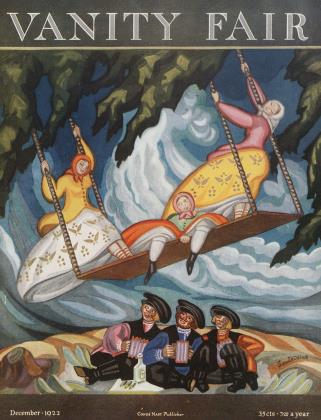Sign In to Your Account
Subscribers have complete access to the archive.
Sign In Not a Subscriber?Join NowThe Fashions and Pleasures of New York
Small Restaurants in By-Streets
JOHN McMULLIN
WHEN dining before the t>lay at seven or seven-thirty, it is necessary to have a short, well-ordered and quickly served dinner so that one gets to the theatre by the first curtain. The first places that come to mind where one is assured of getting just this sort of service, are the Ritz, Sherry's, Pierre or Delmonico. But there are those nights, even in New York, when one wants to make a ceremony of dinner and sit long over coffee in some quiet place with a friend or two, and enjoy life in a more continental way. New York is full of little restaurants where it is possible to sit back from life in this manner. Food in such places is likely to be the food of the peasants of the country from which the proprietor comes, and it is something of a pleasure to change one's diet so completely from our usual fare, that of the cosmopolitan French cuisine.
If there is such a thing as real American cooking, it is to be got only at such places as "Child's" where the cornbeef hash is topped with two poached eggs and the hot cakes are served thick and brown with both butter and maple syrup. But there is another type of American cooking which can be found no where in the world so well as at a wonderful restaurant in Seventh Avenue, down by Twenty-fifth Street, called "Castle Cave." If you do not know this place, a real experience is in store for you. A long room, with a grill in the rear, where one can walk about and see the dinner being prepared and where the chef will ask you "would you like a little more of this, or that" and where one can have the fun of mixing one's own mustard sauce for the steak, or preparing one's pet salad dressing with just that personal touch.
The grill is aglow with hickory coals, The "dish" of the place is a soup plate filled with hot coals on which are placed clams freshly opened, over which a bacon sauce is poured. I am sure that nowhere else can it be done like that. Their mutton chops are twice the size of the ordinary self-respecting chop and they serve them with browned potatoes, done with bacon, and a heaping dish of brown, crisp fried onions. It is a place to go when in the mood to linger long over dinner and consider it carefully with an Epicure's eye.
For English food, The Piccadilly in West 45th Street can show a side of beef so big that it has to be wheeled around on a wagon by an attendant who carves the slices to your taste, and recovers the juice which drips down into the gravy pan in a way which only the English understand. This place is oddly reminiscent of Simpson's in London, famous the world over for its beef and mutton. The Piccadilly also makes a specialty of beefsteak and kidney pies, Dover sole and deep dish apple pies, This is the food of the taverns of England, but one has to admit that these dishes are made no better there than here.
Everyone has his pet Italian restaurant, but I will tell you a secret about them, The perfect host is the man who is wise enough to go himself and order the real Italian dinner under the guidance of the patron. Then instead of having soup, fish, broiled chicken and salad, one can have Minestrone, an enormous dish of spaghetti, or risotto and chicken done in the Italian style which is much more appealing than the broiled chicken of the French chef. At real Italian restaurants one should have for one course a vegetable cooked in oil. The Italian residents of New York say that for this one should go to a little restaurant in Lexington Avenue near 42nd Street called "Napoli."
For odd food there is nothing more surprising than the Mexican dinners one can get at Joel's, upstairs over a little cafe in West 41st Street, next to the National Theatre. The head waiter there, if one has a private interview with him, will conjure up marvelous surprises, Also by way of entertainment, there is a man who plays the piano and some entertainers who sing. In an open space in the middle of the floor one can dance. This restaurant reminds one of the foreign restaurants in San Francisco before the fire, which had more atmosphere than any places of their kind have ever had in this country. There is no one who has not had a weakness for hors d'oeuvres,— sometimes to an extent positively dangerous—so that plenty are found to appreciate the Danish restaurant called Henry's in 36th Street, near Sixth Avenue, where they cannot be excelled. Here one dines very early, between half past six and seven, because in the middle of the room there is an enormous table spread with thirty-five or more different kinds of hors d'oeuvres and it is a case of "First come, first served." The feast can be imagined. It is possible to lose all sense of selection and feel only a desire to try everything. Danish hors d'oeuvres are like those one finds in Russia; in fact, the food in Denmark is as delicious as any food to be found in Europe. The rest of the dinner is equally tempting if one has not been floored by the hors d'oeuvres.
 View Full Issue
View Full Issue












Subscribers have complete access to the archive.
Sign In Not a Subscriber?Join Now